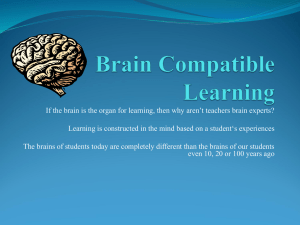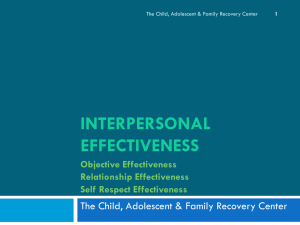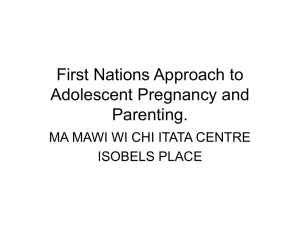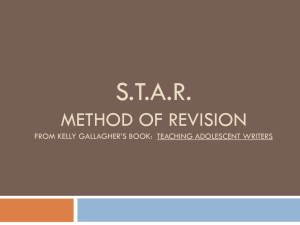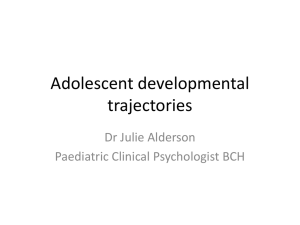Walking the Middle path - The Child, Adolescent and Family
advertisement
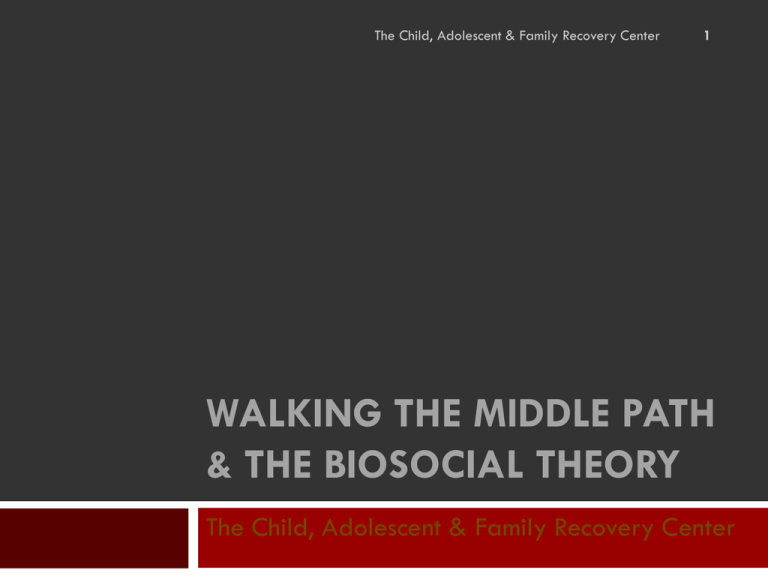
The Child, Adolescent & Family Recovery Center 1 WALKING THE MIDDLE PATH & THE BIOSOCIAL THEORY The Child, Adolescent & Family Recovery Center Walking the Middle Path 2 ACCEPTANCE AND CHANGE The Child, Adolescent & Family Recovery Center Walking the Middle Path 3 HOW DO WE WALK THE MIDDLE PATH?? DIALECTICS VALIDATION BEHAVIORISM The Child, Adolescent & Family Recovery Center Dialectics: What does it mean? 4 WHAT DOES DIALECTICS MEAN?? HOW DO WE THINK AND ACT DIALECTICALLY?? Multiple points of view Examples – Multiple ways to solve a problem Both/And thinking Examples: Avoid “my way or the highway” or “all or nothing” thinking Change is constant The Child, Adolescent & Family Recovery Center Dialectics: Dialectical Dilemmas 5 Forcing Autonomy Excessive Leniency Pathologizing Normal Behavior Normalizing Pathological Behavior Foster Dependence The Child, Adolescent & Family Recovery Center Authoritarian Control Validation: Levels of Validation Level Four Validate the person’s behavior in terms of causes (like past events) Validate feelings. I.e. “since your new boss reminds you of your past boss, I can understand that you would feel fearful of meeting with her.” Level One Overall showing interest in the other person (verbal and non-verbal cues) Level Two Reflective Listening. Summarizing what the other person has said. Take a non-judgmental stance Level Three Try to “read” a person’s behaviors, imagine what they could be feeling, thinking, or wishing for. Walking in their shoes. Check for accuracy. Level Five Communicate the person’s behavior is reasonable, meaningful, and effective. Level Six Treat the person as a valid human being- not patronizing or condescending. Recognize a person as they arewith strengths and limitations. Be genuine! And Believe in that person, while seeing their pain. Validation: Validate Self 7 WHAT DOES VALIDATE MEAN?? COMFORT YOURSELF BY... OBSERVE AND DESCRIBE CURRENT EMOTIONS ACKNOWLEDGE EMOTIONS AS REAL NO MATTER WHAT THE EMOTION OR SITUATION YOU ARE THE EXPERT ON YOU! DON’T EXPECT OTHERS TO KNOW HOW YOU FEEL – work to communicate feelings to others and deal with feelings in a more productive way The Child, Adolescent & Family Recovery Center Validation: Validating Others 8 OBSERVE THE EXPERIENCE – NON JUDGEMENTALLY AND WITH ACKNOWLEDGMENT DESCRIBE THE BEHAVIOR YOU SEE WITH FACTS VALIDATION DOES NOT MEAN AGREEMENT OR APPROVAL VALIDATION = TELLING SOMEONE YOU “GET IT” LEVELS OF VALIDATION The Child, Adolescent & Family Recovery Center Validation: An invalidating environment is one that: 9 Pervasively: negates, punishes, corrects, ignores or dismisses behavior… …whether it is valid behavior or not. - Indiscriminately rejects communication of private experiences and self-initiated behaviors - Intermittently reinforces escalation of emotional responses and displays - Instead, the environment teaches individuals to actively self-invalidate and search social environment for cues about how to respond. The Child, Adolescent & Family Recovery Center Behavioraltech.org Validation: An invalidating environment teaches adolescents to 10 1. Invalidate themselves and look to their social environment for cues on how to respond because their environment unknowingly rejects communication of private experiences and uncomfortable behaviors. 2. Oscillate between emotional inhibition and extreme emotional styles due to the environment punishing emotional displays and unintentionally reinforcing emotional escalation. 3. Form unrealistic goals and expectations as the environment over-simplifies the ease of problemsolving and meeting goals. The Child, Adolescent & Family Recovery Center Behavioraltech.org Behaviorism 11 PROMOTING CHANGE IN BEHAVIORS REINFORCEMENT SHAPING EXTINCITION OF MALADAPTIVE BEHAVIORS INCREASING HEALTHY AND EFFECTIVE USE OF DBT COPING STRATEGIES The Child, Adolescent & Family Recovery Center Behaviorism The Child, Adolescent and Family Development Center would recommend reading Don’t Shoot the Dog! The New Art of Teaching and Training, by Karen Pryor. Behaviorism: (Adapted from Don’t Shoot the Dog) Reinforcement Shaping* Untraining- Using reinforcement to get rid of behaviors you do not want Eliminate the object/person Punishment Negative Reinforcement Extinction Train an incompatible behavior Put the behavior on cue Shape the Absence Change the motivation BIOSOCIAL THEORY WHERE DIALECTICAL BEHAVIOR THERAPY COMES FROM Biosocial Theory 15 Biological dysfunction* in the emotion regulation system + an Invalidating environment = Pervasive Emotion Dysregulation Pervasive Emotional Dysregulation = Emotional Vulnerability* + Inability to Modulate Emotions The Child, Adolescent & Family Recovery Center Behavioraltech.org Biological Dysfunction in the emotion regulation system of adolescents: 16 Problem Areas Skills 1. Confusion about self 1. Mindfulness 2. Impulsivity 2. Distress Tolerance 3. Emotional Instability 3. Emotion Regulation 4. Interpersonal Problems 4. Interpersonal Effectiveness 5. Adolescent-Family 5. Walking the Middle Path Dilemmas The Child, Adolescent & Family Recovery Center Behavioraltech.org What do we mean by Emotional Vulnerability? 17 •High Sensitivity •Immediate reactions •Low threshold for emotional reaction •High Reactivity •Extreme reactions •High arousal dysregulates cognitive processing •Slow return to baseline •Long-lasting reactions •Contributes to high sensitivity to next emotional stimulus The Child, Adolescent & Family Recovery Center Behavioraltech.org So what do we mean by Inability to Modulate Emotions? 18 Difficulty managing inappropriate behaviors related to strong emotions Difficulty acting in a way that is not mood dependant Difficulty self-soothing Difficulty refocusing attention in the presence of a strong emotion The Child, Adolescent & Family Recovery Center Behavioraltech.org What is Biosocial Theory? 19 Biological Dysfunction in the emotion regulation system + an Invalidating environment = Pervasive Emotion Dysregulation The Child, Adolescent & Family Recovery Center Behavioraltech.org
